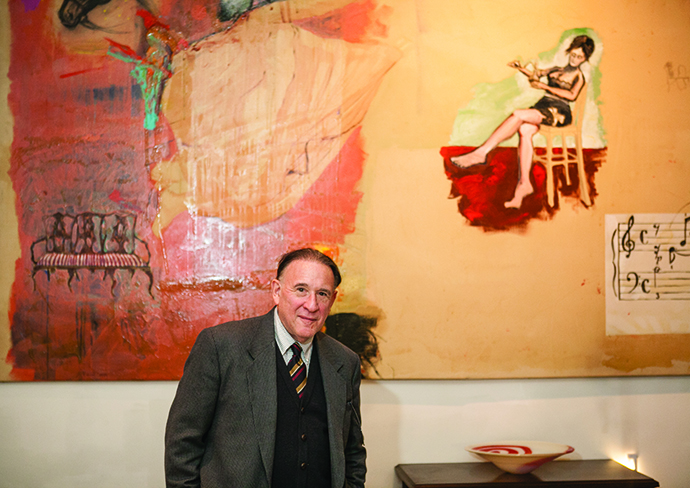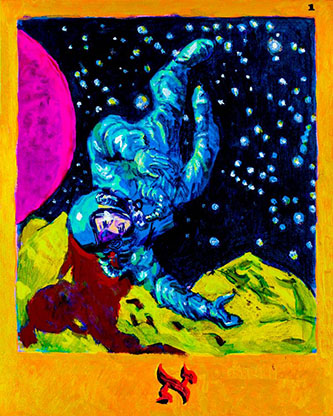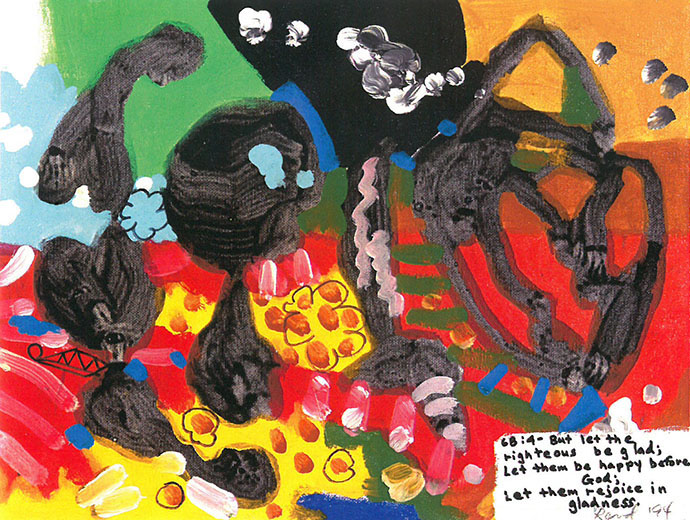Art Professor Archie Rand Is Named Farash Fellow, Receives $100,000 and a Summer Residency at University of Rochester
June 19, 2019
The award recognizes Rand for his pioneering work in contemporary Jewish art and iconography.

Newly Named Farash Fellow Professor Archie Rand of the Brooklyn College Department of Art in front of his 1982 painting Fragrance
Brooklyn College Presidential Professor of Art Archie Rand has been named a Farash Fellow for the Advancement of Jewish Humanities and Culture, sponsored by the Max and Marian Farash Charitable Foundation. Rand, who is the second recipient of the $100,000 award and summer residency at the University of Rochester, is known for his groundbreaking works of contemporary Jewish iconography.
“It was a happy surprise on so many different levels as one cannot apply but is selected for this honor by an anonymous panel,” he says. “The prize was incredibly validating, but I’m most grateful for the unusual recognition that this announcement gives. The fact that I’m following the initial recipient [renowned Israeli author Amos Oz] is really the most exciting thing. The acknowledgement of my continuing narrative engagement that the foundation has chosen to bestow on this body of work—that’s the real shock—that somebody was actually looking at and appreciating what I had been doing.”

'To Know There Is A God' (Exodus 20:2) one of the laws from the Torah in Archie Rand's work 'The 613'
Kicking off his residency in Rochester in 2020, the university’s Memorial Art Gallery will open an exhibition of “The 613,” a 1,700 square-foot painting of individual contiguous panels depicting an exhaustive list of commandments from the Torah. In it, Rand uses a mid-20th-century American comic art style, and references works by Post-Impressionist artists Paul Cézanne and Édouard Manet to marry profane image to sacred text. The result is unique, if sometimes challenging to categorize. “Not only is the work not discursive in the contemporary aesthetic,” says Rand, “it’s not work for which the art world has any support position. It also is rejected from mainstream Judaism. The aesthetic community had no reason or need to absorb this. And the religious community had no use for these items. But I felt the work needed to be made manifest to establish the peoplehood of a marginalized culture.”
Although Rand himself is Jewish but non-observant, his work is often suffused with religious themes and imagery. He has sometimes worked in sacred spaces, including Brooklyn’s B’nai Yosef Synagogue, where his 11,000-square-foot murals have illuminated the walls since 1974. He continued to merge the temporal with the spiritual in exhibitions such as the 2014 “Gods Change, Prayers Are Here to Stay,” at the Katz Gallery in Atlanta, Georgia, and that same year, “Psalm 68” at the Derfner Judaica Museum in the Bronx. The biblical passage is described by Rand in the catalog as “being recited by ‘a gang of juveniles who’ve just done something horrific to another gang of juveniles and is crowing about how great they are,’” but to him, still “absolutely lovely in their humility and their gratitude,” and relatable to life today in all its paradoxical messiness. Rand’s early 2019 exhibition, “Misfits” at the Totah Gallery in New York City were portraits of characters derived from the Lamed Vav Tzadikkim, in mystical Judaism, the 36 righteous people living anonymously in the world in every generation. They can communicate with the Divine Presence, but are ordinary citizens, slipping out of their usual roles to intervene on the behalf of humanity when disaster looms. They are so anonymous that they themselves do not know they are one of the 36. Rand’s “Misfits” are “agents of salvation,” wrote Ann McCoy in The Brooklyn Rail, brought “into our daily lives and an art world that could use their help.”

'68:4 — But let the righteous be glad; Let them be happy before God; Let them rejoice in gladness.' from the series of paintings 'Psalm 68'
A native of Brooklyn, Rand’s first individual show was held at the New York Tibor de Nagy Gallery in 1966. After studying at the Art Students League of New York under abstract painter Larry Poons, he earned a bachelor of fine arts in Cinegraphics from Pratt Institute in 1970. Since then, he has had more than 100 solo shows and 200 group exhibitions worldwide. His works can be found, among others, in the Metropolitan Museum of Art, Museum of Modern Art, Whitney Museum, the Brooklyn Museum, the San Francisco Museum of Modern art, the Art Institute of Chicago, the Victoria and Albert Museum in London, the Bibliothèque Nationale in Paris, and the Tel Aviv Museum of Art. Many of his projects have been collaborations with renowned poets such as John Ashbery, Robert Creeley, David Plante, David Shapiro, Clark Coolidge, and John Yau, among many others.
Formerly chair of the Department of Visual Arts at Columbia University, Rand came to Brooklyn College as The Presidential Professor of Art in 2004, encouraged by then Distinguished Professor of Art History Jack Flam. “I was at the height of academia [at Columbia] when I took the offer to come to Brooklyn College. In the first year or two, I was amazed at the amount of genuinely honest inquiry that came from the students. They have incredible originality. There’s a real joy in teaching here.”






